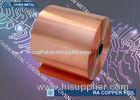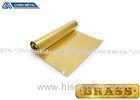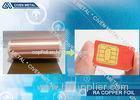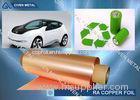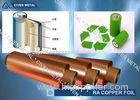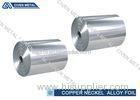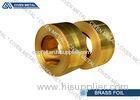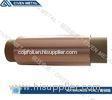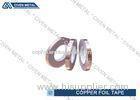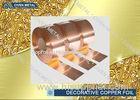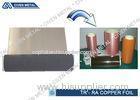C5210 Qsn 8 - 0.3 Standard Alloy Foils / Bronze Foil With Maximum Width 650mm
| Place of Origin: | Guangdong, China (Mainland) |
|
|
|
| Add to My Favorites | |
| HiSupplier Escrow |
Product Detail
C5210 (Qsn 8 - 0.3) Standard Bronze Foil With Maximum Width Of 650mm
Descrip
C5210 (Qsn 8 - 0.3) Standard Bronze Foil With Maximum Width Of 650mm
Description:
Bronzes are typically very ductile alloys. By way of comparison, most bronzes are considerably less brittle than cast iron. Typically bronze only oxidizes superficially; once a copper oxide (eventually becoming copper carbonate) layer is formed, the underlying metal is protected from further corrosion. However, if copper chlorides are formed, a corrosion-mode called "bronze disease" will eventually completely destroy it. Copper-based alloys have lower melting points than steel or iron, and are more readily produced from their constituent metals. They are generally about 10 percent denser than steel, although alloys using aluminium or silicon may be slightly less dense. Bronzes are softer and weaker than steel—bronze springs, for example, are less stiff (and so store less energy) for the same bulk. Bronze resists corrosion (especially seawater corrosion) and metal fatigue more than steel and is a better conductor of heat and electricity than most steels. The cost of copper-base alloys is generally higher than that of steels but lower than that of nickel-base alloys.
Copper and its alloys have a huge variety of uses that reflect their versatile physical, mechanical, and chemical properties. Some common examples are the high electrical conductivity of pure copper, the low-friction properties of bearing bronze (bronze which has a high lead content— 6-8%), the resonant qualities of bell bronze (20% tin, 80% copper), and the resistance to corrosion by sea water of several bronze alloys.
The melting point of bronze varies depending on the ratio of the alloy components and is about 950 °C (1,742 °F). Bronze may be nonmagnetic, but certain alloys containing iron or nickel may have magnetic properties.
Due to bronze foil has unique performance, it has been broadly used as anti-abrasion material of electronic devices components, high air tightness casting, connectors, pins and high precision instruments. It has following features:
- high phosphorus content, great fatigue resistance;
- Good elasticity and abrasive resistance;
- No magnetic, good mechanical properties and process performance;
- Good corrosion resistance, easy to weld and braze, and no spark upon impact;
- Good conductivity, safe in high temperature.
Chemical Composition (%)
|
Alloy No. |
Density (g/cm³) |
Sn |
P |
Cu |
|
|
China |
Japan |
||||
|
Qsn8-0.3 |
C5210 |
8.0 |
7.0-9.0 |
0.03-0.25 |
91.9 |
Mechanical Properties (Standard : GB/T5189-1985)
|
Alloy No |
JIS Temper |
Tensile Strength Rm/N/mm 2 |
Elongation(%) |
HV Temper |
|
C5210 |
1/2H |
470-610 |
27 |
140-205 |
|
H |
590-705 |
20 |
185-235 |
|
|
EH |
680-780 |
11 |
205-230 |
|
|
SH |
735-835 |
9 |
230-270 |
Note: We can provide products with other properties according to customers` requirements.
Specifications Available (mm)
|
Thickness |
Width |
Temper |
|
0.01 ~ 0.1 |
1.0~650 |
Customized |
Sizes and Tolerances (mm)
|
Thickness |
Thickness Tolerances |
Width |
Width Tolerance |
|
0.01 ~ 0.6 |
± 0.002 |
1.0~650mm |
± 0.1 |
|
>0.06 ~ 0.1 |
± 0.003 |
Factory Shows

Our Contact :

Related Search
Find more related products in following catalogs on Hisupplier.com
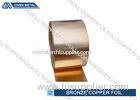
Company Info
Civen Metal Material Co.,Ltd [China (Mainland)]
Business Type:Manufacturer
City: Shanghai
Province/State: Shanghai
Country/Region: China (Mainland)











